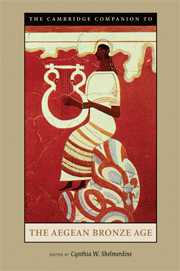Book contents
- Frontmatter
- 1 Background, Sources, and Methods
- 2 The Early Bronze Age in Greece
- 3 The Early Bronze Age in the Cyclades
- 4 Early Prepalatial Crete
- 5 Protopalatial Crete
- 6 The Material Culture of Neopalatial Crete
- 7 Minoan Culture: Religion, Burial Customs, and Administration
- 8 Minoan Crete and the Aegean Islands
- 9 Minoan Trade
- 10 Early Mycenaean Greece
- 11 Mycenaean Art and Architecture
- 12 Mycenaean States
- 13 Burial Customs and Religion
- 14 Mycenaean Greece, the Aegean and Beyond
- 15 Decline, Destruction, Aftermath
- Glossary
- Select Bibliography
- Index
- Plate section
6 - The Material Culture of Neopalatial Crete
Published online by Cambridge University Press: 28 November 2010
- Frontmatter
- 1 Background, Sources, and Methods
- 2 The Early Bronze Age in Greece
- 3 The Early Bronze Age in the Cyclades
- 4 Early Prepalatial Crete
- 5 Protopalatial Crete
- 6 The Material Culture of Neopalatial Crete
- 7 Minoan Culture: Religion, Burial Customs, and Administration
- 8 Minoan Crete and the Aegean Islands
- 9 Minoan Trade
- 10 Early Mycenaean Greece
- 11 Mycenaean Art and Architecture
- 12 Mycenaean States
- 13 Burial Customs and Religion
- 14 Mycenaean Greece, the Aegean and Beyond
- 15 Decline, Destruction, Aftermath
- Glossary
- Select Bibliography
- Index
- Plate section
Summary
General Outline of the Period
The Neopalatial (or New Palace) period followed the fire destructions at the end of the Protopalatial period (MM II) and continued until the fire destructions at the end of LM IB, which destroyed almost all administrative sites in Crete (the central palace building at Knossos was spared) and changed Minoan culture. The period is conventionally divided into a short MM III period, which is difficult to characterize, and a long LM IA period and LM IB that together may have been the highpoint of the Minoan civilization.
Early in the Neopalatial period the Minoans extended their cultural and administrative influence beyond Crete. By LM IA we see their presence in the Cyclades (especially Thera, Keos, and Melos; Ch. 8, pp. 189-97), in other islands such as Kythera and the northern Aegean island Samothrace, and on the west coast of Anatolia (Miletos; Chs. 8, pp. 198-200; 9, p. 217). Besides being long and rich, LM IA also saw the eruption of the Thera volcano late in the period (Ch. 1, p. 6). Theran pumice has been found at many Cretan sites, where sometimes it had been carefully collected and stored, and several sites were wrecked by earthquake and either remodeled (Petras east of Siteia) or abandoned (the farm complex at Vathypetro). Other sites were simply abandoned, such as Galatas in the Pediada plain southeast of Knossos. More material dates to LM IB, simply because the fire destructions that closed the period were nearly total and apparently sudden; although no people were burned to death in the buildings, they left behind just about everything except their personal jewelry.
- Type
- Chapter
- Information
- The Cambridge Companion to the Aegean Bronze Age , pp. 140 - 164Publisher: Cambridge University PressPrint publication year: 2008
- 6
- Cited by



